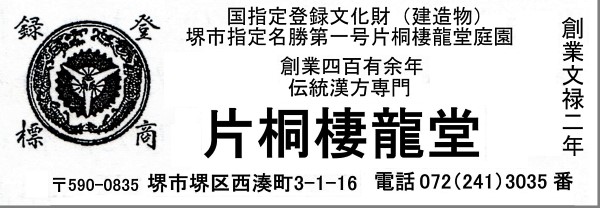
KATAGIRI SEIRYUDO PHARMACY
| “OrientaI Bezoar" and Todaiji Temple Oriental Bezoar is a miracle medicine of'animal origin that hasmaintained a reputation as a life-saving drug among oriental medicines from ancient times. The oriental bezoar or Niu-Huang (牛黄=Go-o in Japanese pronunciation)in Chinese already appeared in the Chinese old medical books such as Shen-Nong Ben-Cao Jing(神農本草経=Materia Medica of Deity of Agriculture =an earliest medical material dictionary compiled in Later Han Dynasty in China or 1st to 2nd Century of the Christian era),and Ming Yi Bie lu (名医実録=Miscellaneous Records of Famous Physicians)written by Tao Hong-jing (陶弘景)during 5th to 6th Century In Japan, it was firstly recorded in Shoku-Nihongi (続日本紀=The Chronicles of Japan)edited by Fujiwara-no-Tsugutada et al. in 797 A.D., saying it has been introduced at the days of Empress Suiko around 6th Century. This medicine was called as “UShi-no-Tama" in Japan and it was derived from the name firstly shown as “Ushi-no-tama (=Pearl from Ox)was applied for Japanese name for Go-o."in the (Tamba-)Yasuyori Honzo ((丹波)康頼本草=Yasuyori's Materia Medica) in 10th Century and was explained in the animals division in the old classification of “Yakushou-Noudoku Taisei (薬性能毒大成=Treatise of Medicinal and Toxic Properties) written by Manase Dosan in the 16th Century that “Go-o" had a Japanese name of “Ushi-no-Tama". After the so-called Sengoku-Era (=the period of warring states during 15th to 16th Century),it was getting more common to be called by “Ushi-no-Tama" for Go-o. While the medicinal books in the Edo-era during 18th to early 19th century such as Senkin-Houyaku Tyuu (千金方薬註=valuable Medicine Formulations Commentary) and Honzo-Koumoku Keimou (本草綱目啓蒙=Enlightenment for Compendium of Materia Medica)reported that not so many but small quantities of cattle gallstones were available in O-mi district, the records on clinical experiences have scarcely maintained to date. However,there is a fact descended today in support of a story that Go-o was widely utilized in the Nara-era of the 8th century. The Todaiji temple (meaning the eastern great temple)was established by Emperor Shomu and his consort Komyoshi provided in the Todaiji such places for their social works as Seyaku-in (施薬院=Charitable Dispensary)and Hiden-in (悲田院=the Asylum for the helpless suffering from diseases or hunger).Their spirits come through inour own days so tht Ryoyakusho (領薬処= Delivery Point)in Seyaku-in at Nigatsu-do (the Hall of February)in the Todaiji distributes saffron decoction called “Kannon-to” to those who wants to be given. (It is said that the products vvere offered even for free to the needy in the ancient time.)The religious event of “Shuni-e” (=修二会=The Meeting of February Practice),commonly known as “Omizutori”(=Drawing of Holy Water),is held at Nigatsu-do during the period from 1st to 14th February in the lunar calendar and it has never been stopped from its beginning for about 1,250 years. The Buddhist monks called Rengyoshu (練行衆 =Practioners),who lead ascetic practices with praying during Shuni-e, prepare the limited numbers of special paper talismans and hand them out to the memberships ofl believers gathering for the event. The paper talismans so called as “Go-o Fuda” or “Darani Fuda” are special as they are not regarded as medicines but are more than common type of lucky charm for incantation against sickness or evils. “Go-o Fuda” is written as “牛玉札” of which “牛”is for “ox” or “cattle”, and “玉”is for "ball" or “gem”. Although it should have been phonetically spelled as “牛王札”of which “王”has a meaning of “king”, they daringly use “玉”that is pronounced as “gyoku” in Japanese. The reason for using “玉”instead of "王”is thought because of "Go-o Fuda” is printed with liquid ink containing Go-o (namely, oriental bezoar).Therefore,it is not just a lucky charm but also has long time been used as a medicine such as for cardiac, sedative, or antipyretic, with a custom among believers for a long time to tear into small pieces and eat them. For more than twelve centuries, Todaiji has been attempting to bolster up “sprits and minds” of people and Go-o Fuda can be said as a typical example of such attempts coming together with healing powers of oriental bezoar and wonder・work of sutra. |
原文をそのまま英訳しても理解は難しいと思われましたので、多少の解説を交えてアレン ジしました。 以下に和訳を記します。 「牛黄」と東大寺様 牛黄は古代より東洋医学で命を救う薬と位置づけられた神秘の動物由来薬です。 牛黄(ごおう、中国語発音でNiu・Huang)は後漢の時代に編纂された最古の医薬辞典であ る神農本草経(=Materia Medica of Deity of Agriculture)や、5・6世紀ごろ、陶弘景が著 した名医実録(=Miscellaneous Records of Famous Physicians)など中国の古代の医学書 に既にその名が見えています。日本では、藤原続縄等が編纂した続日本紀(The Chronicles of Japan continued)に最初の記録があり、6世紀頃の推古天皇の時代に我が国に伝わったと されます。 。この薬の和名は「ウシノタマ」と呼ばれ、これは10世紀頃、(丹波)康頼本草(Yasuyori’s Materia Medica)に「牛黄の和名は宇之乃知(うしのたま=牛の珠)である」との記載に由 来しており、16世紀の曲直瀬道三の薬性能毒大成(Treatise of Medicinal and Toxic Properties)の古類の禽部にも、「牛黄の和名は牛の多末(たま)」とあります。 15世紀から 16世紀に掛けて戦乱期、所謂、戦国時代以降、牛黄をウシノタマと呼ぶことが多くなりま した。 18世紀から19世紀の江戸時代の医薬書である千金方薬註(valuable Medicine Formulations Commentary)や本草綱目啓蒙(Enlightenment for Compendium of Materia Medica)には近江地方で多くはないが少量の牛黄が採集できると記載されており ますが、臨床に関する記録は今日まで殆ど残っていません。 しかしながら、8世紀の奈良時代には牛黄が広く利用されていたという説を裏付ける事実 が今日に伝わっています。東大寺様(東の偉大な寺院の意味)は聖武天皇により創建され、 皇后である光明氏は東大寺様内に彼らの社会事業の場として、施薬院(無料医薬品頒布所) や悲田院(病気や飢えに苦しむ困窮者の収容施設)を設けました。彼らの精神は今日にも 受け継がれており、東大寺様内の二月堂にある施薬院の領薬所(薬の引渡所)では「観音湯」 と呼ぶサフランの湯剤を希望者に頒布しています。(昔は貧困者には無料で配布されたとい われています。)陰暦の2月1−14日の間、二月堂では「お水取り」(聖なる水の汲み取り) として知られる修二会(しゆうにえ=2月修行の法要)という宗教行事が行われており、こ の行事は凡そ1、250年前から欠かさず続けられています。修二会の間、誦経し修行を率い る練行衆と呼ばれる修行憎が限られた数の特別の護符を用意し、行事に参加した信者に授 けます。牛王札(ごおうふだ)或いは陀羅尼札(だらにふだ)と呼ばれる紙の護符は特別 なもので、薬ではありませんが、ただの病気や悪霊退散の護符でもありません。「ごおうふ だ」は牛玉札と書き、「ご」は牛、「おう」は玉と書き、珠玉の意味です。「玉」は「ぎょく」 と続むので、本来、音に忠実に書けば「おう」は「王」の字を使って「牛王札」とするべ きですが、あえて「玉」の字を用いています。「王」の代わりに「玉」を用いている理由は 牛玉札が牛黄を含んだ墨汁を使って刷られているためと考えられます。このため、牛玉札 は単なる護符ではなく、強心、鎮静、解熱などの薬として長い間、用いられ、信者の間で は札を細かく千切って食べる習慣がありました。 12世紀を越える間、東大寺様は人々の「心とこころ」を支え続けており、牛黄の薬効と経 文の霊力が一体となった牛玉札はかかる試みの典型的な一例といえましょう。 |
